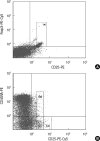Subpopulations of regulatory T cells in rheumatoid arthritis, systemic lupus erythematosus, and Behcet's disease
- PMID: 22969245
- PMCID: PMC3429816
- DOI: 10.3346/jkms.2012.27.9.1009
Subpopulations of regulatory T cells in rheumatoid arthritis, systemic lupus erythematosus, and Behcet's disease
Abstract
Recently, subpopulations of regulatory T (Treg) cells, resting Treg (rTreg) and activated Treg (aTreg), have been discovered. The authors investigated the relationship between the change of Treg, aTreg and rTreg and autoimmune diseases. Treg cells and those subpopulations were analyzed by using the human regulatory T cell staining kit and CD45RA surface marker for 42 rheumatoid arthritis (RA), 13 systemic lupus sclerosis (SLE), 7 Behcet's disease (BD), and 22 healthy controls. The proportion of Treg cells was significantly lower in RA (3.8% ± 1.0%) (P < 0.001) and BD (3.3% ± 0.5%) (P < 0.01) compared to healthy controls (5.0% ± 1.3%). The proportion of aTreg cells was also significantly lower in RA (0.4% ± 0.2%) (P = 0.008) and BD (0.3% ± 0.1%) (P = 0.013) compared to healthy controls (0.6% ± 0.3%). The rTreg cells showed no significant differences. The ratio of aTreg to rTreg was lower in RA patients (0.4% ± 0.2%) than that in healthy controls (0.7% ± 0.4%) (P = 0.002). This study suggests that the decrement of aTreg not rTreg cells contributes the decrement of total Treg cells in peripheral blood of RA and BD autoimmune diseases. Detailed analysis of Treg subpopulations would be more informative than total Treg cells in investigating mechanism of autoimmune disease.
Keywords: Autoimmune Diseases; Behcet Disease; Regulatory T Cells; Rheumatoid Arthritis; Systemic Lupus Erythematosus.
Figures



Similar articles
-
Increased CD45RA+ FoxP3(low) regulatory T cells with impaired suppressive function in patients with systemic lupus erythematosus.PLoS One. 2012;7(4):e34662. doi: 10.1371/journal.pone.0034662. Epub 2012 Apr 10. PLoS One. 2012. PMID: 22506043 Free PMC article.
-
Regulatory T cells in Behçet's disease: is there a correlation with disease activity? Does regulatory T cell type matter?Rheumatol Int. 2013 Dec;33(12):3049-54. doi: 10.1007/s00296-013-2835-8. Epub 2013 Aug 3. Rheumatol Int. 2013. PMID: 23912800
-
Increased Levels of STAT1 Protein in Blood CD4 T Cells from Systemic Lupus Erythematosus Patients Are Associated with Perturbed Homeostasis of Activated CD45RA-FOXP3hi Regulatory Subset and Follow-Up Disease Severity.J Interferon Cytokine Res. 2017 Jun;37(6):254-268. doi: 10.1089/jir.2016.0040. Epub 2017 Mar 3. J Interferon Cytokine Res. 2017. PMID: 28256939
-
Regulatory T cells (Treg) in rheumatoid arthritis.Joint Bone Spine. 2009 Jan;76(1):10-4. doi: 10.1016/j.jbspin.2008.08.002. Epub 2008 Nov 22. Joint Bone Spine. 2009. PMID: 19028128 Review.
-
Regulatory T-cells in systemic lupus erythematosus and rheumatoid arthritis.FEBS Lett. 2011 Dec 1;585(23):3603-10. doi: 10.1016/j.febslet.2011.07.043. Epub 2011 Aug 4. FEBS Lett. 2011. PMID: 21827750 Review.
Cited by
-
Changes in peripheral blood T lymphocyte subsets predict disease progression in patients with rheumatoid arthritis.Am J Transl Res. 2022 Feb 15;14(2):1068-1075. eCollection 2022. Am J Transl Res. 2022. PMID: 35273709 Free PMC article.
-
Treg cells in autoimmunity: from identification to Treg-based therapies.Semin Immunopathol. 2019 May;41(3):301-314. doi: 10.1007/s00281-019-00741-8. Epub 2019 Apr 5. Semin Immunopathol. 2019. PMID: 30953162 Review.
-
Regulatory T Cell and Forkhead Box Protein 3 as Modulators of Immune Homeostasis.Front Immunol. 2017 May 26;8:605. doi: 10.3389/fimmu.2017.00605. eCollection 2017. Front Immunol. 2017. PMID: 28603524 Free PMC article. Review.
-
Analysis of FOXP3+ regulatory T cell subpopulations in peripheral blood and tissue of patients with systemic lupus erythematosus.Immunol Res. 2017 Apr;65(2):551-563. doi: 10.1007/s12026-017-8904-4. Immunol Res. 2017. PMID: 28224362
-
Comparison of Regulatory T-Cell Subpopulations in Antithymocytic Globulin Versus Post-Transplant Cyclophosphamide for Preventing Graft-Versus-Host Disease in Allogeneic Hematopoietic Stem Cell Transplantation-A Retrospective Study.Int J Mol Sci. 2025 Mar 11;26(6):2521. doi: 10.3390/ijms26062521. Int J Mol Sci. 2025. PMID: 40141165 Free PMC article.
References
-
- Baecher-Allan C, Brown JA, Freeman GJ, Hafler DA. CD4+CD25high regulatory cells in human peripheral blood. J Immunol. 2001;167:1245–1253. - PubMed
-
- Yagi H, Nomura T, Nakamura K, Yamazaki S, Kitawaki T, Hori S, Maeda M, Onodera M, Uchiyama T, Fujii S, et al. Crucial role of FOXP3 in the development and function of human CD25+CD4+ regulatory T cells. Int Immunol. 2004;16:1643–1656. - PubMed
-
- Kuhn A, Beissert S, Krammer PH. CD4(+)CD25 (+) regulatory T cells in human lupus erythematosus. Arch Dermatol Res. 2009;301:71–81. - PubMed
Publication types
MeSH terms
Substances
LinkOut - more resources
Full Text Sources
Other Literature Sources
Medical

